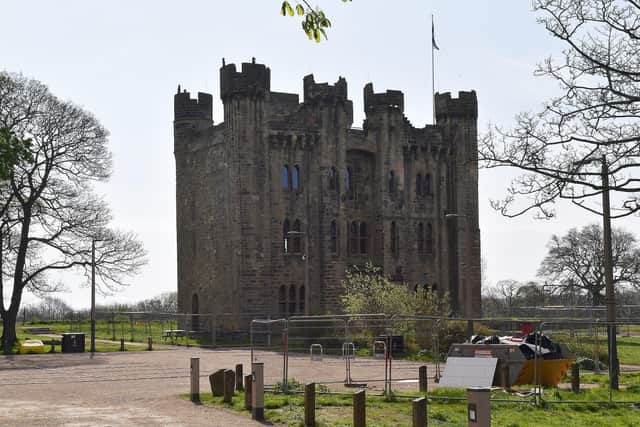The story of the Cauld Lad of Hylton Castle, Sunderland’s most famous ghost
and live on Freeview channel 276
Some poltergeists are apparently capable of deliberately spilling a pint of lager. This chilled the heart of many a reader who had previously been unconcerned by the supernatural.
As we all know, every pub in Britain is haunted. It’s actually written into the 2003 Licensing Act – but nobody knows who put it there.
Advertisement
Hide AdAdvertisement
Hide AdThis makes eminent sense if you think about it. If you were a spirit, pondering where to spend your indefinite ethereal existence, you wouldn’t choose to spend the centuries clanking around in Wellington Lane scrapyard, splendid scrapyard though it is.


No. You would pick yourself a nice cosy boozer. Or perhaps an opulent stately home, or castle.
Which brings us neatly, if not contrivedly, to Sunderland’s most celebrated spook, the Cauld Lad of Hylton Castle. Whooooo-ooo!
The unfortunate stable boy


The story of the Cauld Lad (pronounced as in "howled” and meaning “cold” for the benefit of any tourists who might be reading) is as follows. We think.
Advertisement
Hide AdAdvertisement
Hide AdIt’s nearly Halloween, so gather round and prepare to quiver.
In the 16th or 17th century, we can’t be more precise, a stable boy at the castle called Robert Skelton was caught carrying out one of two possible misdemeanours.
Either he had failed to prepare the horse of his boss, the thoroughly unpleasant Baron Robert Hylton who needed the mount for a journey; or he had been caught in a romantic tryst with Hylton’s daughter.


The more we discover about the baron the more we hope it was the latter. Or better still, both. Whatever the transgression, Robert Skelton was going to be punished.
Advertisement
Hide AdAdvertisement
Hide AdFortunately for the youngster, his master was in a good mood and he got away with merely being run through on the spot with a pitchfork; or possibly battered to death with a riding crop; or decapitated with a sword.
If it was indeed a pitchfork, the implement was then put to a more legitimate use. Hylton temporarily hid the body under some straw before later dumping it in a pond, or maybe down a well. It was discovered months later.
The baddie Baron was eventually put on trial for murder, but managed to produce an alibi. A farm hand claimed Hylton had ordered Skelton to remove a tool from the top shelf in the barn, the youngster fell and seriously injured himself. Hylton claimed he attended to the casualty himself, but to no avail.


Records show that according to a 1609 inquest, Hylton was found to have killed someone with a grim reaper-style scythe.
Advertisement
Hide AdAdvertisement
Hide AdBut back in those days wealthy people tended not to be treated overly harshly by legal processes and the mega-wealthy and powerful Hylton was granted a free pardon.
Sightings of the ghost
The story is so full of contradictions and obvious flaws that people 400 years ago wouldn’t have known what to believe never mind us.
Of more interest to self-appointed paranormal experts is what happened next, after the boy’s murder/accidental death.
According to the early 19th century historian Robert Surtees (no shortage of Roberts around here), Skelton’s ghost appeared in Hylton Castle’s great hall and would break dishes in the kitchen.
Advertisement
Hide AdAdvertisement
Hide AdThe ghost can’t have had much else to do as he would sometimes play with people’s minds by messing up a tidy kitchen, or tidying up a messy kitchen. He might take hot ashes from the fires, then lie on them to leave an imprint of a body.
Most horrifyingly of all, he would sometimes empty chamber pots onto the floor. Lovely.
Eventually a cook who was sick of all the mess stayed up all night to see what was going on. He saw the ghost of Robert Skelton, who wailed “I’m cauld!”.
The ghost might well have been cauld as he was also naked, which would account for the hot ashes.
Advertisement
Hide AdAdvertisement
Hide AdThe cook must have been a good egg as he and his wife left some warm clothing for the ghost, who was so grateful that he treated them to some rapping.
The next night the couple heard: “Here’s a cloak and here’s a hood; The Cauld Lad of Hylton will do no more good.”
The hood was the more essential item of the two, as otherwise it wouldn’t have rhymed.
Even more importantly it seems certain ghosts are exorcised if they are given a gift, and the spectre was never seen or heard again.
Or was he? Whooooo-ooo!
Advertisement
Hide AdAdvertisement
Hide AdVarious Hylton Castle residents, guests and staff over the centuries have claimed unusual sightings and hearings.
In more recent times a security guard at a nearby building site claimed that The Cauld Lad turned off his red lights and put out his fire. So perhaps he’s not so cauld these days, now that he has that cloak and hood.
The Cauld Lad’s colleagues
There are other well-known ghosts around Sunderland and they too tend to inhabit high profile buildings.
An inevitable white lady wanders around Washington Old Hall, wailing and wringing her hands. She may have lost her purse.
Advertisement
Hide AdAdvertisement
Hide AdAnother spook is said to haunt the Stadium of Light. Although it was only built in 1997, owners Sunderland AFC have a long association with shadowy figures.
Theatres have almost as many ghosts as pubs. This includes the Sunderland Empire, where the spectral box office must be doing a roaring trade as resident phantoms are said to include Sid James and Vesta Tilley.
But the Cauld Lad of Hylton Castle is the real A-lister.
